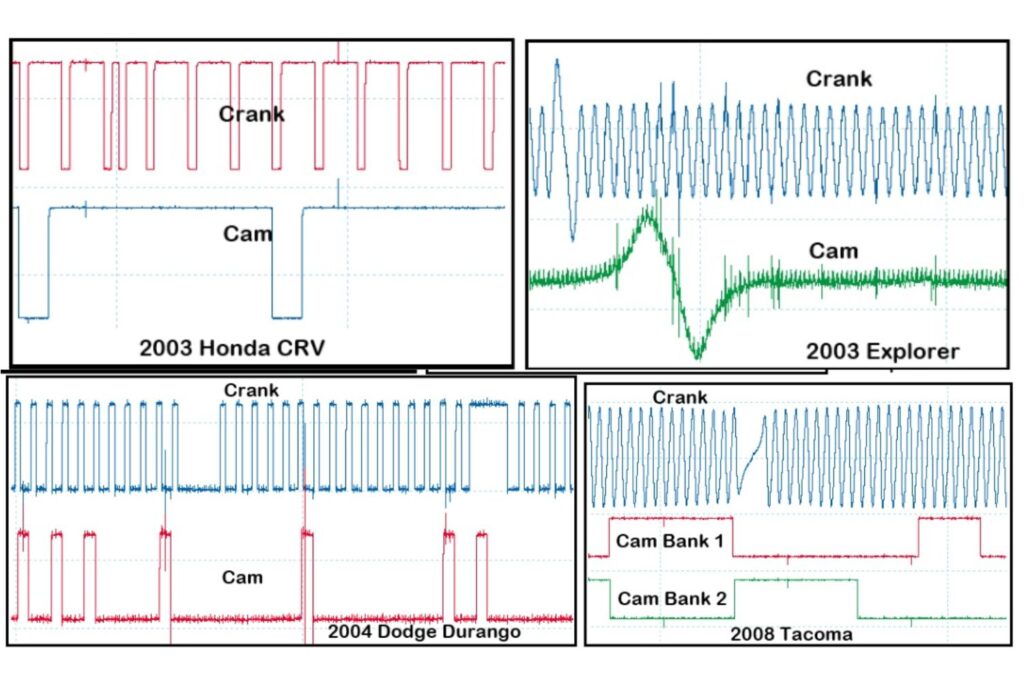Your vehicle utilizes several sensors to keep the engine running properly. The crankshaft position sensor (CKP) and camshaft position sensor (CMP) are critical for proper engine function. However, over time, these sensors can fail. When they do, your engine might have issues such as a check engine light, engine misfires, increased fuel consumption, and an engine that cranks but refuses to start.
A lot of components can cause these issues. Hence, testing the CKP and CMP sensors is critical to rule them out as the source of these problems.
What Do the Camshaft and Crankshaft Position Sensors Do?
The CMP and CKP sensors can detect the speed and position of their corresponding parts. The vehicle’s computer or powertrain control module (PCM) needs this information to control the spark, fuel injection, and variable valve timing.
A piston’s stroke has four stages: intake, compression, power, and exhaust. Since the engine’s crankshaft is a rotating assembly connected to the pistons, the PCM can know each piston’s status by looking at the crankshaft’s position.
Meanwhile, the camshaft is a rotating shaft that spins. As it spins, lobes on the shaft push a series of valves that allow air to enter and exit the combustion chamber. The PCM needs to know when the camshaft will open and close the engine’s valves. Hence, understanding its speed and position is crucial.
How Do the Camshaft and Crankshaft Position Sensors Work?
The CKP can detect the speed and position of the crankshaft using a magnet. The CKP sensor typically relies on a part called a harmonic balancer, which is essentially a notched wheel that spins alongside the crankshaft. As the wheel spins, the metal teeth pass over the CKP sensor, which uses an electromagnet to create the electrical signals sent to the PCM.
The CMP sensor operates in the same manner. However, the sensor reads the notches of a wheel or plate located at the end of the corresponding camshaft.
Tips on Testing the Camshaft and Crankshaft Position Sensors
Locate the Sensors
Wondering how to test the crankshaft position sensor? You first need to find it on your engine.
The crankshaft position sensor is typically located on the front of the engine block, near the engine timing chain cover. Sometimes, the crankshaft position sensor can be at the back of the engine, near the flywheel. You can easily spot the sensor because it usually has a wire sticking out.
Meanwhile, the camshaft position sensor is located in the front of the engine, near the camshaft gears. Once you’ve found the sensor, you can press on a tab that unlocks it and pull it out.

Look for Damage and Dirt
If there are any signs of damage on the sensor, then it’s an obvious sign that there’s something wrong and the sensor could be to blame for your vehicle’s engine issues. Inspect the sensor’s plastic body and the metal pins. If there are cracks or bent pins, then that could be a sign that the sensor has failed. At the same time, check the metal pins for oil or dirt that might affect the electric current.
Determine if the Sensors Are Two-Wire or Three-Wire Variants
CMP and CKP sensors both work similarly, which means you can use the same method to test both sensors. That said, there are CMP and CKP sensors with two or three wires and they’re tested differently.
You need to determine whether your sensor is a two-wire or three-wire variant by checking how many wires are sticking out of the sensor.
Two-wire sensors can create an electrical signal using a magnet. When the metal tooth passes over the magnet’s magnetic field, the magnet will create a current that’s sent to the PCM. Meanwhile, three-wire sensors also have a magnet. However, three-wire sensors need a constant voltage from the vehicle to work.
Test the Two-Wire Sensor for Continuity
Testing a crankshaft position sensor is simple. A crankshaft position sensor test involves getting a multimeter and setting it to the 20,000 ohms setting. Connect the two multimeter leads to the two metal prongs on the sensor. If the sensor can detect a value of 200 to 1000 ohms, then your sensor is running properly. However, if the multimeter displays a value of zero, then there’s likely a short circuit.
Test the Two-Wire Sensor for Voltage
The most important way to test your two-wire sensor is to check if it’s producing voltage. To do this, set your multimeter to its AC setting with a sensitivity value of 2 volts. Once your multimeter leads are connected to the sensor’s prongs, you can try to pass a metal object like a screw over the sensor. If the multimeter detects voltage as you move the metal object over the sensor, then it means the sensor is working.
Test the Three-Wire Sensor
Wondering how to test a camshaft position sensor with three wires? A three-wire sensor has a wire that receives power, another wire that sends signals to the PCM, and then the last wire connects to a ground source.
First, you must determine which wire on the sensor’s connector provides the power.
To do this, set the multimeter to its DC setting with a sensitivity value of 20 volts. Connect the multimeter’s black lead to a battery. Then, using the red lead, test each metal prong on the sensor’s connector. Take note that you’re testing the sensor’s connector, which is where the sensor’s wiring harness plugs into. The multimeter should have a reading once the red lead makes contact with the sensor’s constant wire.
Next, you must determine the sensor’s ground wire from the two remaining wires. Set the multimeter to its ohms setting, then test the two remaining wires. If the multimeter detects a reading, then that should be your ground wire. The last remaining wire should then be the signal wire.
Unlike a two-wire sensor, three-wire sensors need to be tested while connected to the vehicle. Set your multimeter to its DC setting with a sensitivity value of 20 volts. To test your sensor, you need to connect back probe connectors to the ground and signal wire. A back probe connector is a sharp metal rod that pierces the insulator, allowing you to connect the leads without stripping the wires.
Once you’ve connected the back probe connectors to your multimeter leads, turn the ignition. You should see an electrical signal coming from the signal wire. If there isn’t a signal, then your sensor could be shorted.
A faulty CKP or CMP sensor is a serious engine problem. If your vehicle has this problem, then it’ll show symptoms that are difficult to ignore. As long as you follow the steps outlined in this article, you’ll be able to properly test your sensors and determine if they’re the cause of your engine issue.
How to Get Your Hands on Replacement Camshaft and Crankshaft Position Sensors
It’s not a good idea to drive a vehicle with inoperative components – especially if this includes the camshaft and crankshaft position sensors. If these auto parts ever malfunction or get damaged, it’s important to replace them as soon as possible.
Whether you’re new to cars or an expert DIYer, finding replacement parts designed to work with your vehicle shouldn’t be difficult. That’s where CarParts.com comes in. We’re committed to helping you find quality parts at competitive prices.
Items in our catalog are vetted by a team of professionals to guarantee performance and longevity. You won’t have to worry about your new camshaft and crankshaft position sensor failing you any time soon.
To get started, use your mobile device or computer to visit our website. Input all of your vehicle’s details such as the year, make, model, and engine with the vehicle selector.
Any information provided on this Website is for informational purposes only and is not intended to replace consultation with a professional mechanic. The accuracy and timeliness of the information may change from the time of publication.



































